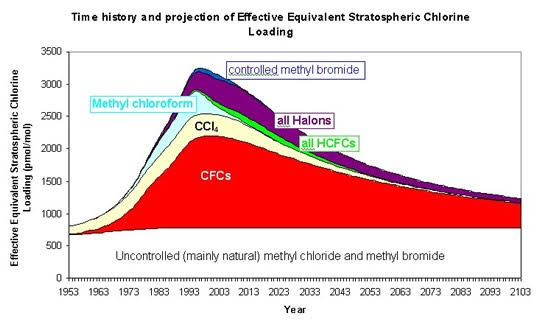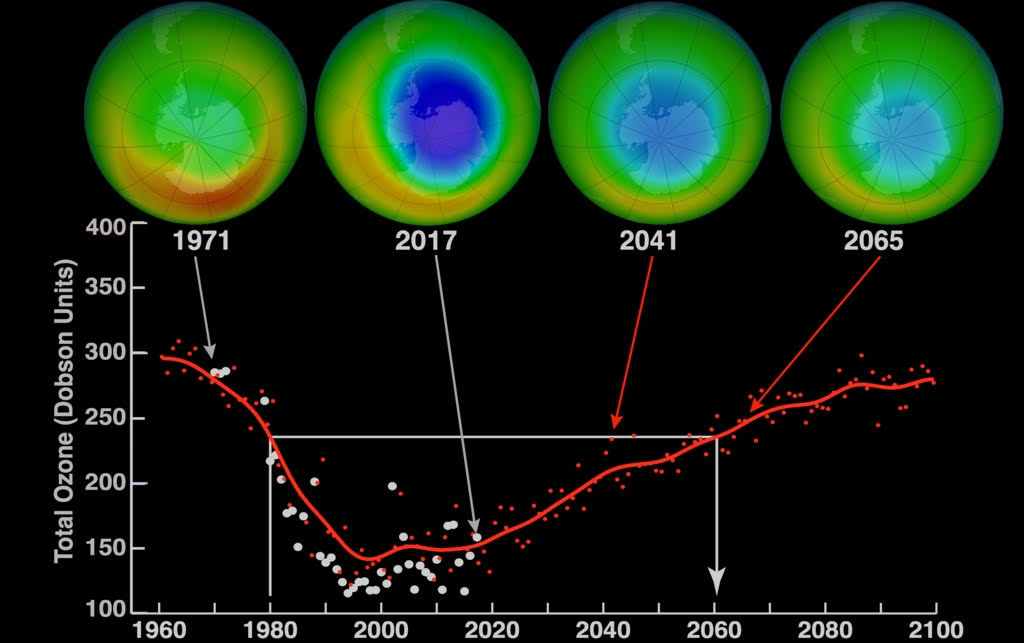On World Ozone Day 2020, relearning forgotten lessons from past global success for COVID19
It was the decade of 1970s. A dozen men had already landed on the moon. There was an exhilarating mood all around, mainly in the developed countries. ‘‘Sky is not the limit,’’ scientists and technocrats would often boast. The doors of the universe could be commanded from a tiny control room on the Earth to explore the unknown, the deepest secrets of the universe and indeed our planet. Or so went the thinking amongst the superpowers who believed they had unravelled every little secret and held them within their clinched fists.
Then came the bomb shell and as it happens always, it came from nowhere. Scientists from USA and Europe who were literally policing the atmospheric traffic of chemicals in the skyways observed that certain man-made chemicals had shocking potential to attack the Stratospheric Ozone Layer which is the only shield that made life on the Earth a possibility. The Ozone layer halts the harmful ultraviolet radiation from the Sun reaching the Earth. That was the first alarm raised by the scientist and nobel laureate Mario Molina, and scientists F. Sherwood Rowland and Paul Crutzen in 1974 about an impending crisis at global scale.
They cautioned that the chemicals like chlorofluorocarbons or CFCs and others which were nearly pervasive in our homes, offices as well as cars, trains and ships, were the primary threat to the Ozone layer and that loss of the protective cover would be calamitic for the Earth. They predicted the catastrophe that included huge rise in skin cancer, loss of immunity, blindness due to cataract and above all the loss of crops on the land and fish in the oceans.
The scientists had unwittingly taken on a very powerful lobby of USD 28 billion CFC industry whose products ranged from home insulating materials to solvents for electronic equipment. The industry promptly rejected the claim by the trio and insisted that the CFCs were safe and there was no evidence of any damage to the ozone layer. They also tried to discredit the scientists by alluding various motives to them for targeting the CFC industry.
Luckily for the humanity, not only did Molina, Rowland and Crutzen continue with their crusade to save the Ozone layer, they were soon able to find allies in other scientific domains and finally convinced the international organisations as well as some political leaders to at least stop and listen to their warnings.
It was at this stage that the United Nations Environment Programme (UNEP) took the lead and convened the global community of scientists to assess, observe, evaluate and verify the warnings given by the Molina and his colleagues. By 1980s, the alarm triggered by them and their predictions began to come true and in a much worse manner when the scientists actually observed a huge loss of ozone over Antarctic. That came to be known as ozone ‘hole’. The scientists then were able to conclusively prove the link between ozone hole and emissions of man-made ozone-depleting substances (ODS), particularly the CFCs. It was clear that if no action was taken the ozone depletion would spread over all the latitudes of the Earth, not just at the poles.
Under the authoritative assessment of the observation by United Nations Environment Programme and World Meteorological Organization, the countries agreed to take time-targeted actions to eliminate the production and consumption of Ozone Depleting Substances world over. From the moment that the precarity of the situation became clear, UNEP very successfully chaperoned an unprecedented global coordination and cooperation to get the nations and businesses to move rapidly to save the ozone layer. In 1985, the Vienna Convention for Protection of the Ozone Layer was signed, signalling the intent of the global community to take prompt action. Barely two years later, and at a record pace for a complicated global negotiation that involved scientists, businesses, political leaders as well as multilateral bodies, the world’s first substantial and performance-driven multilateral environmental treaty, The Montreal Protocol on the Substances that Deplete the Ozone Layer was signed. The developing countries had successfully negotiated the financial and technology assistance arguing that the most of the damage to Ozone Layer was due to industrial activities that originated in the developed countries and the developed nations had to provide assistance to the developing world to phase out CFCs. Fairly soon afterwards, all the 196 member states of the United Nations had signed and ratified the Montreal Protocol.
In the 35 years after the conclusion of the Vienna Convention and 33 years after the Montreal Protocol, the world witnessed that the country after country shut down manufacturing facilities of nearly 2 million tonnes per year of chemicals that were damaging and hollowing out the ozone layer. More than 98 pc of consumption of such chemicals is now assigned to history books of chemistry. That too as per the specified time in the Protocol. India and China met their targets before the Protocol’s deadlines. Small countries like Bhutan who had consumption of few kg per annum, too, stopped their consumption in time and replaced them with newly developed and existing alternatives. Thus, with a balanced treaty, global participation and time bound targets that have been respected by all countries alike, the rising curve of ozone depletion was not only flattened, but the ozone layer is now well on its way to recovery.
That was a feat acclaimed by all including the United Nations, who in its 2007 report to General Assembly said, ‘‘The Montreal Protocol demonstrates what can be achieved when countries act together and in concerted way to resolve global environmental problems”. The UN report went on to state that more than 250 million cases of skin cancer and almost 50 million cases of cataracts will have been averted by the end of the 21st century as a result of concerted global action to recover ozone layer.
Today, as the global community fights the coronavirus pandemic in the year 2020, there are several uncanny parallels between the battle to save the ozone layer and the battle to rid the earth of the Covid-19 virus that seems to continue to profligate with great ease.

Continuous monitoring and curbing prevalence of ODS & GHGs is key to success
The warning for ozone was issued by Molina et al in 1974, almost a decade before the world took note and began to act. The warning against COVID19 pandemic was first given in 2015 by none other than the first Tech Moghul of the world, Bill Gates, who is now the leading health warrior of the world.
Gates raised the alarm about an approaching pandemic on his session on TED Talk in 2015. But practically no one paid any heed to him. The world was too busy with profiting from an ever-rising Dow Jones index and hence took it as yet another health-related nudge from Gates. Four years later, in 2019, there was the famous Chinese doctor, Dr Li Wenliang of Wuhan hospital, who raised the alarm about the coronavirus in the early days of the COVID19 outbreak. He tried to send a message to fellow medics about the outbreak before pandemic spread globally. Unfortunately, the Chinese police told him to stop spreading rumours as important elections were taking place in the province and political leaders did not want to create chaos.
Fearing for his life, Li did shut up and Bill Gates’ warning went into the oblivion. So when barely a few weeks after being first noticed in Wuhan, the SARS-CoV-2 virus, also known as coronavirus that causes COVID19 began raging uncontrollably across the globe, just like in a Hollywood sci-fi thriller.
As with ozone, even with coronavirus, the globe failed to pay attention before it was too late. But as with ozone layer, it is only with global cooperation and coordination that the world can hope to win over Covid19. Act together and act now is a lesson from the ozone layer for the pandemic.
Additionally, there was singularly significant but unintended bonus of such global environmental movement. CFCs and some of the other ozone depleting chemicals are also potent and thousands of times more global warming than carbon dioxide. By 2010, unintended benefits of Montreal Protocol resulted in preventing release of these ozone depleting and green-house-gases (GHGs) of about 15 Gigatonnes (Gt) of equivalent CO2 emissions annually. This is much more than the 2 Gt per year that were targeted but never met by the Kyoto Protocol by 2012.
Kofi Annan, former United Nations Secretary General, in his famous report We the people: The Role of United Nations in 21st century said “Perhaps the single most successful international environmental agreement to date has been the Montreal Protocol, in which states accepted the need to phase out the use of ozone-depleting substances”. Here in lies another lesson for battle against COVID19. When the world comes together to fight common cause, there are always unintended co-benefits.
Success breeds success and even more success. The countries in 2016 decided to correct the necessary mistake they had unknowingly committed while eliminating CFCs. The alternative hydrofluorocarbons, HFCs, were deployed as part of the alternatives to eliminate CFCs. But while the HFCs were ozone friendly, they were not climate friendly. Global warming potential of some of the HFCs was tens of thousand times more than carbon-dioxide. After extensive debate, the Protocol Parties decided to phase down use of HFCs as well in stages with clear targets. The Montreal Protocol thus became only climate change treaty today that is working and has agreed timetable with full incremental cost assistance to the developing countries. Global success encourages innovation and eagerness to continue to tackle new challenges, together. This is yet another valuable lesson for the world fighting COVID19.
The Protocol continues to keep close eye through atmospheric observations and their impacts on ozone Layer. The possibility of ‘second wave’, to use COVID19 terminology, of ‘ozone depletion pandemic’ is distant but not impossible. Indeed, the dangerous instances of restarting of small quantities of CFCs production and consumption in China have been noted from the atmospheric observation over last few years. Though they do not match with the observed increase in atmospheric concentration, investigation is on-going. Leaks from already stored CFCs, by-product-HFCs from manufacture of legally allowed chemicals and illegal trade are potentially serious issues that could jeopardise the success of the Protocol.
So, these issues are being debated in the Protocol’s global meetings with full transparency. Provision of such open and democratic mechanism to address the aberrations in the success of the Protocol itself is considered as one of the drivers of the successes of the ozone treaty. There is growing need for chemical inspectors to check and verify the data submitted by the countries under the Montreal Protocol as is done under United Nations Organisation of Chemical Weapon Treaty (OPCW) in The Hague.
Honest and urgent evaluation of early warning signals of global calamity, science and technology based global collective and corrective actions, financial and technical assistance from developed countries to developing countries, respectful follow up of open and transparent investigation are the most important lessons for the countries engaged in lethal fight against COVID19.
If UN can demonstrate an immensely successful example of a global treaty that avoided the calamity at planetary level, why can the same UN not use its convening power to address the global pandemic? UN still can catalyse action and provide a platform to win the war against COVID19. That would be yet another inspiring lesson to the world from UN in its 75th anniversary.
The author is chairman TERRE Policy Centre and former Director UNEP. He was global head of capacity building programme in UNEP to protect the Ozone Layer and the coordinating lead author special report of IPCC-2007 that won the Nobel Peace Prize.










